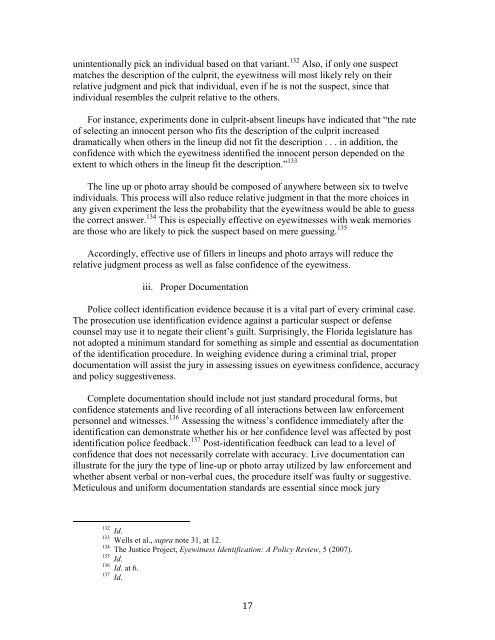dada_floridamisidentification_final - UDC Law Review
dada_floridamisidentification_final - UDC Law Review
dada_floridamisidentification_final - UDC Law Review
- No tags were found...
Create successful ePaper yourself
Turn your PDF publications into a flip-book with our unique Google optimized e-Paper software.
unintentionally pick an individual based on that variant. 132 Also, if only one suspectmatches the description of the culprit, the eyewitness will most likely rely on theirrelative judgment and pick that individual, even if he is not the suspect, since thatindividual resembles the culprit relative to the others.For instance, experiments done in culprit-absent lineups have indicated that “the rateof selecting an innocent person who fits the description of the culprit increaseddramatically when others in the lineup did not fit the description . . . in addition, theconfidence with which the eyewitness identified the innocent person depended on theextent to which others in the lineup fit the description.” 133The line up or photo array should be composed of anywhere between six to twelveindividuals. This process will also reduce relative judgment in that the more choices inany given experiment the less the probability that the eyewitness would be able to guessthe correct answer. 134 This is especially effective on eyewitnesses with weak memoriesare those who are likely to pick the suspect based on mere guessing. 135Accordingly, effective use of fillers in lineups and photo arrays will reduce therelative judgment process as well as false confidence of the eyewitness.iii. Proper DocumentationPolice collect identification evidence because it is a vital part of every criminal case.The prosecution use identification evidence against a particular suspect or defensecounsel may use it to negate their client’s guilt. Surprisingly, the Florida legislature hasnot adopted a minimum standard for something as simple and essential as documentationof the identification procedure. In weighing evidence during a criminal trial, properdocumentation will assist the jury in assessing issues on eyewitness confidence, accuracyand policy suggestiveness.Complete documentation should include not just standard procedural forms, butconfidence statements and live recording of all interactions between law enforcementpersonnel and witnesses. 136 Assessing the witness’s confidence immediately after theidentification can demonstrate whether his or her confidence level was affected by postidentification police feedback. 137 Post-identification feedback can lead to a level ofconfidence that does not necessarily correlate with accuracy. Live documentation canillustrate for the jury the type of line-up or photo array utilized by law enforcement andwhether absent verbal or non-verbal cues, the procedure itself was faulty or suggestive.Meticulous and uniform documentation standards are essential since mock jury132 Id.133 Wells et al., supra note 31, at 12.134 The Justice Project, Eyewitness Identification: A Policy <strong>Review</strong>, 5 (2007).135 Id.136 Id. at 6.137 Id.17














